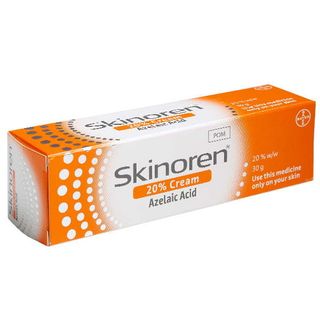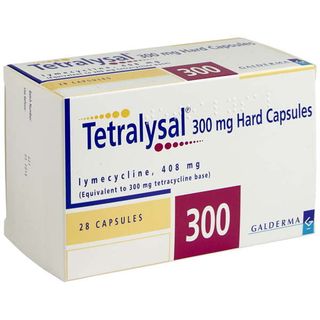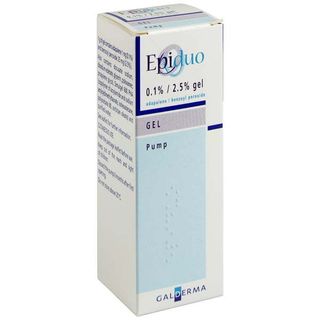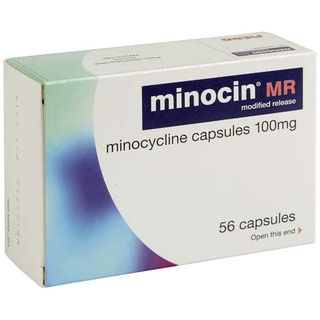
- Fast, discreet delivery
- 100% UK-based pharmacy
- Free advice and support
- We're rated 4.9 out of 5
Based on over 30,000 reviews collected on Google and Reviews.io.
We maintain the highest possible regulation for a UK online pharmacy, ensuring your experience is safe, and confidential.
Buy Clindamycin and Benzoyl Peroxide 5% Gel (Generic Duac) Online in the UK
Clindamycin and Benzoyl Peroxide Gel is a powerful formula effective against harmful bacteria, visibly reducing blackheads, whiteheads and red inflamed spots.
Buy Clindamycin and Benzoyl Peroxide 5% online today from The Independent Pharmacy when you complete an online health consultation for review and approval by our UK-based clinical team. In just a few simple steps you can get your treatment delivered straight to you at home.
- 3
- 2
Clindamycin + Benzoyl Peroxide Summary
Clindamycin and Benzoyl Peroxide Gel (generic Duac) information
What is Clindamycin and Benzoyl Peroxide gel?
Clindamycin and Benzoyl Peroxide gel is a topical medication used primarily for the treatment of acne vulgaris, a common skin condition characterized by clogged pores, inflammation, and sometimes bacterial infection.
How does Clindamycin and Benzoyl Peroxide work?
Clindamycin is an antibiotic that works by inhibiting the growth of acne-causing bacteria on the skin, and Benzoyl Peroxide is a topical medication with both antimicrobial and keratolytic properties. It works by killing bacteria on the skin's surface and within pores, while also helping to remove dead skin cells and excess oil. This helps to prevent the formation of new acne lesions and promote the healing of existing ones.
Are there alternative acne treatments?
There are several alternative acne treatments available, depending on the severity of the acne and individual factors such as skin type and tolerance to certain medications. For more information, see our acne treatments page.
How does this differ from Duac?
Duac is a brand-name medication that contains two active ingredients: Clindamycin Phosphate and Benzoyl Peroxide. It is primarily used for the topical treatment of acne vulgaris.
The generic version of Duac contains the same active ingredients, Clindamycin phosphate and Benzoyl Peroxide, but it is typically sold under its chemical names rather than a brand name. Generic medications are approved by regulatory agencies, such as the MHRA, as equivalent to the brand-name drug in terms of safety, efficacy, dosage, strength, route of administration, quality, and intended use.
The main difference between Duac and its generic version lies in their branding and pricing. Brand-name medications like Duac are usually more expensive than their generic counterparts because brand-name companies invest in research, development, and marketing of the drug. Once the patent protection for the brand-name drug expires, other pharmaceutical companies can produce generic versions, which often results in lower prices due to competition.
In terms of effectiveness and side effects, Duac and its generic version should be equivalent since they contain the same active ingredients in the same concentrations. However, inactive ingredients (excipients) such as preservatives, fragrances, or stabilisers may differ between the brand-name and generic versions.
While these differences are typically minor and do not affect the medication's overall performance, individuals with sensitivities or allergies to certain ingredients may find that they prefer one formulation over the other.
Do I have to keep Clindamycin and Benzoyl Peroxide in the fridge?
No. While at the pharmacy it is stored in the fridge. Once it has been provided to you it can be safely stored at room temperature but make sure it's not kept in a place where it can get too hot, above 25°C. At room temperature, it can be stored for 2 months. At the correct dose, this will be longer than the cream will last.
If you have ordered more than 1 tube. We would recommend that you store the unused creams in the fridge between 2°C to 8°C. But don't freeze it.
Sources
How to apply Clindamycin & Benzoyl Peroxide Gel
To apply Clindamycin and Benzoyl Peroxide gel effectively, follow these general steps:
- Cleanse your skin: Before applying the gel, wash your face gently with a mild cleanser and pat it dry with a clean towel. Avoid harsh scrubbing or abrasive cleansers, as they can irritate the skin and worsen acne.
- Apply a small amount: Squeeze a pea-sized amount of the gel onto your fingertip or a clean applicator. A little goes a long way, so you don't need to apply a thick layer. Start with a small amount and increase if necessary.
- Dot the gel onto affected areas: Use your fingertip or applicator to dot the gel onto the areas of your skin affected by acne. Focus on areas where you typically experience breakouts or have active pimples.
- Gently massage in: Using clean fingertips, gently massage the gel into your skin until it's absorbed. Be careful not to rub too vigorously, as this can irritate the skin. Allow the gel to dry completely before applying any other skincare products or makeup.
- Wash your hands: After applying the gel, wash your hands thoroughly to remove any residue and prevent accidentally transferring the medication to other areas of your skin or eyes.
- Use as directed: Follow your healthcare provider's instructions regarding the frequency and duration of application. Clindamycin and Benzoyl Peroxide gel is typically applied once or twice daily, but your doctor may adjust the dosage based on your individual needs and response to treatment.
- Be consistent: Consistency is key when using acne medications. Stick to your prescribed regimen and continue using the gel even if you don't see immediate results. It may take several weeks to notice improvements in your acne, so be patient and stay consistent with your skincare routine.
- Monitor for side effects: Pay attention to how your skin reacts to the medication. Some common side effects of Clindamycin and Benzoyl Peroxide gel include dryness, redness, peeling, or irritation. If you experience severe or persistent side effects, consult your healthcare provider.
How long does it take to work?
The time it takes for Clindamycin and Benzoyl Peroxide Gel to reduce your acne symptoms will depend on the condition of your skin and whether you have moderate acne or severe acne. In some cases, it proves highly impactful and makes a visible difference within days, but it normally takes between two and four weeks to yield significant results.
The longer you use the gel, the better the results will be. Following a full 12 week course is most likely to effectively combat your acne, but you mustn’t exceed 12 weeks unless advised to do so by your doctor. Too much Clindamycin and Benzoyl Peroxide Gel can cause antibiotic resistance where bacteria build up resistance to the antibiotics designed to fight them.
Clindamycin and Benzoyl Peroxide Gel ingredients
The active substances in Clindamycin and Benzoyl Peroxide Gel are: clindamycin and hydrous benzoyl peroxide.
The other ingredients are: Carbomer (50000mPa.s), Dimeticone (100mm2.s-1), Disodium Lauryl Sulfosuccinate, Edetate Disodium, Glycerol, Silica, Colloidal Hydrated, Poloxamer 182, Purified Water, Sodium Hydroxide
Clindamycin & Benzoyl Peroxide Gel side effects
One of the most common side effects of this medication is skin irritation. This can manifest as redness, itching, burning, or stinging at the application site. In some cases, the skin may also become dry, flaky, or peel.
Prolonged or excessive sun exposure while using Clindamycin and Benzoyl Peroxide gel may increase the risk of sunburn, skin damage, and premature ageing. It's important to use sunscreen with a high SPF and to limit sun exposure, especially during peak hours, while using this medication.
It's important to note that while these are common side effects, not everyone will experience them, and some individuals may tolerate the medication well. However, if you experience severe or persistent side effects, or if you develop any signs of an allergic reaction (such as rash, swelling, or difficulty breathing), it's crucial to seek medical attention promptly.
Clindamycin and Benzoyl Peroxide gel warnings
Like any medication, Clindamycin and Benzoyl Peroxide gel comes with specific warnings for use. Here are some important warnings associated with this medication:
Avoid Contact with Eyes, Mouth, and Mucous Membranes: Clindamycin and Benzoyl Peroxide gel should not come into contact with the eyes, mouth, or mucous membranes (such as inside the nose). If accidental contact occurs, rinse the affected area thoroughly with water. Avoid applying the gel to areas of broken or irritated skin, as this may increase the risk of irritation or absorption of the medication into the bloodstream.
Sun Sensitivity: Benzoyl Peroxide, one of the active ingredients in this medication, can make the skin more sensitive to sunlight. Prolonged or excessive sun exposure while using Clindamycin and Benzoyl Peroxide gel may increase the risk of sunburn, skin damage, and premature aging. It's essential to use sunscreen with a high SPF and to limit sun exposure, especially during peak hours, while using this medication.
Allergic Reactions: Some individuals may be allergic to Clindamycin or Benzoyl Peroxide, or other ingredients in the gel. Signs of an allergic reaction may include rash, itching, swelling, dizziness, or difficulty breathing. If you experience any signs of an allergic reaction, discontinue use of the medication and seek medical attention immediately.
Pregnancy and Breastfeeding: The safety of Clindamycin and Benzoyl Peroxide gel during pregnancy and breastfeeding has not been well established. If you are pregnant, planning to become pregnant, or breastfeeding, it's essential to discuss the risks and benefits of using this medication with your healthcare provider before starting treatment.
Avoid Using with Certain Products: Clindamycin and Benzoyl Peroxide gel may interact with certain other topical medications or skincare products. Avoid using other acne medications or products containing sulfur, resorcinol, or salicylic acid while using this medication unless directed by your healthcare provider.
Clindamycin and Benzoyl Peroxide Gel (generic Duac) reviews
Clindamycin and Benzoyl Peroxide Gel (generic Duac) FAQs
Is Duac an effective acne treatment?
Duac is a treatment which combines two of the most commonly-used acne treatments. No treatment will completely cure acne, but Duac should remove 2/3 of blemishes within 30 days of use.
First, it contains clindamycin, which is the top antibiotic used to treat acne in both the UK and in Canada. Unlike minocycline (the primary treatment in the US), it will not cause teeth to become stained or discoloured.
The second component is benzoyl peroxide. This is the most popular ingredient in all acne treatments. It contains benzoin and hydrogen peroxide, which kill acne bacteria which remains after the clindamycin treatment. This combination of ingredients ensures that the bacteria will not become resistant to one antibiotic.
Duac tends to work within 48 hours, which is notably faster than other combination acne treatments such as Zineryt or Differin.
Should I keep using my moisturiser?
A moisturiser will help to prevent dry skin, which is very important in treating acne. Moisturiser can be applied over a layer of Duac. However, do not use a moisturiser containing an alcohol, as this may increase skin irritation. Instead, select an alcohol-free alternative.
Will using Duac cause dry skin?
1 in 10 patients who use Duac will notice dry skin to some extent. This may lead to mild redness and peeling where the treatment is applied.
This side effect may be more pronounced when Duac is used in combination with certain other medicines, cosmetics, toiletries or soaps. Specifically, products which contain isotretinoin, tretinoin and tazarotene may interact with benzoyl peroxide and lead to skin irritation. If you must use these products as well as Duac, try to spread out the time of day when you apply them.
How should I store Duac?
Duac should be stored below 25°C and kept for a maximum of two months after opening. Keep all medications away from children.
Can I still drink alcohol when using Duac?
Duac will not react with the drinking of alcohol; however it might react with other topical acne products that contain alcohol.
How will Duac Gel benefit me?
Duac Gel can provide many benefits, the main ones being:
- A reduction in acne on the skin
- Decreases the chance of future outbreaks occurring
- Allows your skin to breath and heal
- It’s a cost effective solution
- By applying Duac directly to the skin, it is able to work faster than other medications, as well as decreasing the chance of side effects
- Some people see benefits within the first few days
Can I buy Duac over-the-counter?
Duac is a prescription only medication and is therefore not available over the counter. In order to purchase Duac gel you will need a prescription from a medical professional.
If I use Duac will my skin dry out?
Approximately 10 percent of individuals who use duac will experience some level of dry skin. This can manifest itself as redness or peeling in the area in which the treatment has been applied. This kind of irritation can become more noticeable if duac is used in conjunction with other medication, cosmetics or toiletries. More specifically, products which contain ingredients such as isotretinoin, tretinoin and tazarotene can increase irritation by interacting with the benozyl peroxide. If you wish to use these products alongside Duac, it might be a good idea to spread them out throughout the day.
How does Duac work?
Duac works by making use of two active ingredients. The first one is called clindamycin, the number one antibiotic in the UK for treating acne. This has benefits over minocycline (which is the number one antibiotic used in the US), as it does not discolour or stain teeth.
The second active ingredient is known as benzyol peroxide, an ingredient which can be found in most acne treatments. The benzoin and the hydrogen peroxide work by killing any acne bacteria remaining on the skin. By combining with clindamycin these ingredients stop the bacteria from becoming resistant to one antibiotic.
Studies have shown that Duac works within 48 hours of use, much faster than any other combination treatment available on the market.
Is Duac once daily gel?
Yes – Duac Gel is intended for once-daily application to help treat and prevent breakouts.
Is Duac Gel safe during pregnancy?
Duac Gel is not recommended during pregnancy. This is because it contains benzoyl peroxide. Consult a medical professional for advice on a suitable alternative if you are pregnant.
Related Treatments
Visit our Acne page for treatments, advice and FAQs.
Ordering as easy as 1, 2, 3
1. Find the ideal treatment
2. Get a free consultation
3. Enjoy speedy delivery



